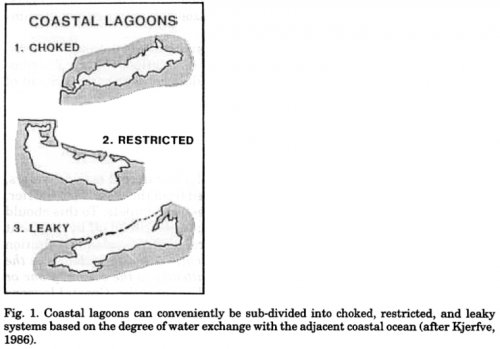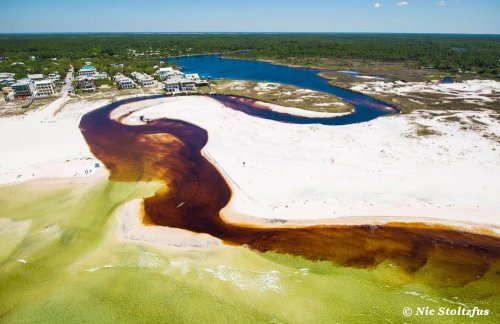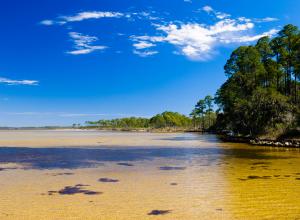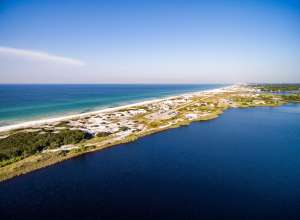Coastal Dune Lakes Episode 2 - How Do Coastal Dune Lakes Work?
June 19, 2014 by Elam Stoltzfus

About two weeks ago, I was sitting in the office and preparing for the first blog I wrote on the coastal dune lakes, and I stumbled across the term “coastal lagoon” on the National Geographic website.
A lagoon is a shallow body of water protected from a larger body of water (usually the ocean) by sandbars, barrier islands, or coral reefs. Lagoons are often called estuaries, sounds, bays, or even lakes. (Emphasis added)
My eyes widened and jaw dropped. “Oh no, oh no. This isn’t good.” I said aloud. The definition for coastal lagoon was very close to that of a coastal dune lake (and this is coming from Nat Geo, so I knew it was official). I continued researching coastal lagoons. Here is a definition of a coastal lagoon from a 1994 article by Dr. Bjorn Kjerve (PhD, Marine Sciences):
Coastal lagoons are inland water bodies, found on all continents, usually oriented parallel to the coast, separated from the ocean by a barrier, connected to the ocean by one or more restricted inlets which remain open at least intermittently, and have water depths which seldom exceed a few meters. A lagoon may or may not be subject to tidal mixing, and salinity can vary from that of a coastal fresh-water lake to a hypersaline lagoon, depending on the hydrologic balance.
I thought about the definition a bit more in regards to the coastal dune lakes in Florida and compared it to the definition put forth by the Florida Department of Environmental Protection in their 2008 e-newsletter, Coastal Currents.
Coastal dune lakes develop from various coastal processes, most commonly when sand deposition fills an inlet to a tidal basin or lagoon…The coastal dune lakes of Walton County are fed by streams, groundwater seepage, rain and storm surge and experience intermittent connection with the Gulf of Mexico. The periodic connection, called an outfall, empties lake water into the Gulf and, depending on tides and weather, salt water and organisms from the Gulf flow back into the lakes.
Among the Walton County lakes, each is different and each outfall is unique. Salinity in the 15 lakes ranges from totally fresh to highly saline, resulting in biologically diverse ecosystems.
Coastal lagoons and coastal dune lakes—they sound a lot alike. But do they look alike? Here is a picture of a coastal lagoon from his article:
 Coastal Lagoon Diagram by Kjerve.
Coastal Lagoon Diagram by Kjerve.
Here is a picture of a coastal dune lake in Walton County, Florida:

The outfall of Western Lake, the coastal dune lake found within Grayton Beach State Park.
Hmm…that visual of a choked coastal lagoon looks a lot like a coastal dune lake, doesn’t it? I wanted a little more information, so I looked up examples of choked coastal lagoons he cited.
There is a choked coastal lagoon in South Africa, St. Lucia. It is part of South Africa’s iSimangaliso Wetland Park, a World Heritage Site. (Map.)
There is a choked coastal lagoon in Thailand—Songkhla Lake. It is the largest natural lake in Thailand and contains brackish water about half as salty as the ocean. (Aerial photo.)
To be fair, both of these are much larger than the lakes found in Walton County—and neither of them have dunes that separate the lakes from the ocean. But—I hadn’t heard of them before, and I was still a little unnerved—what exactly are these lakes we have in SoWal? Should they be coastal dune choked lagoons? Or something else entirely?
Dagnabbit! I felt like I had opened Pandora’s box or taken a bite from the apple in the garden—what once was clear was now obfuscated, muddled.
In order to work my way out of this puzzle, I e-mailed Dr. Sarah Schindele, grant coordinator for the Choctawhatchee Basin Alliance and superhero extraordinare. Sarah has been my main contact in finding out more about all things science-related to the dune lakes. She wasn’t sure how to answer my question, so she put me in touch with a professor she knew at University of West Florida’s Department of Environmental Studies, Dr. Klaus Meyer-Arendt. Dr. Meyer-Arendt received his PhD in Geography and Marine Science from Louisiana State University (like Dr. Kjerfve). He currently specializes in coastal research, so I knew he would be able to provide me with accurate information in regards to my question. Here is what he replied in an e-mail to me and Dr. Sarah Schindele:
…coastal dune lakes–including those of Walton County–comprise a subset of choked coastal lagoons. Dr. Kjerfve is a very respected oceanographer, and his article is very comprehensive. I personally always interpreted coastal lagoons as being linear, parallel to the shore, and normally free of freshwater input. Dr. Kjerfve’s article points out that this is not always the case. So, in terms of a typology of coastal waterbodies, I would tend to go along with him.
…these lakes are not very common but that they have been classified as a subset of coastal lagoons. I don’t believe that lessens their importance…..and their special status in Florida.
Ah…it made a little more sense now. I still want to make 100% sure that this is true and that coastal dune lakes are a subset of a choked coastal lagoon, so I am currently in the process of contacting Dr. Kjerfve. Once I find out more information from him, I will include it in my next update about the coastal dune lakes.
I thought more about it all—coastal dune lakes are a subset of a larger grouping. Kinda like—like birds! The Snowy Plover (Charadrius nivosus) is found in the plover bird family (Charadriidae). The Northern Cardinal (Cardinalis cardinalis) is found in the cardinal bird family (Cardinalis). Both bird families are branches under the much larger bird class (Aves). Defining coastal dune lakes in this way doesn’t make them any less rare or unique; this definition situates it in a larger framework and is a starting point for conversation about coastal systems around the world.
Attached is a video that we did here at Live Oak Production Group featuring the coastal dune lakes of South Walton and how they work. Enjoy!
















